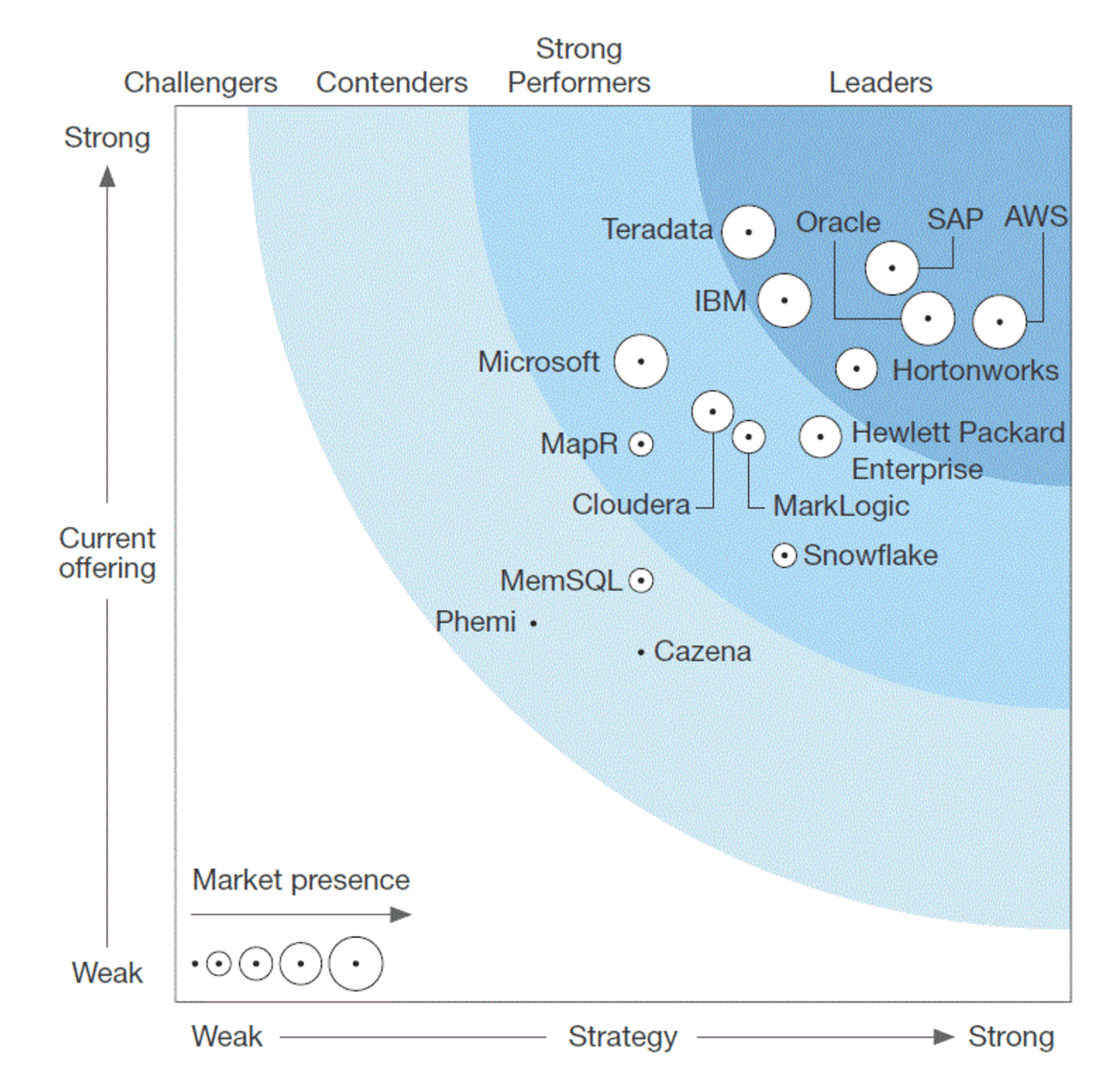How to Best Understand Forrester’s Crazy Big Data Warehouse Rankings
Executive Summary
- Forrester has one of the most insane Big Data or data warehouse rankings (we can’t tell which) that we have ever seen.
- Reviewing this ranking is its form of comedy and indicator of how little Forrester knows about the topic.

Introduction
In Forrester’s “Big Data Warehouse” 2017 ranking, Forrester made some peculiar decisions related to where to rank vendors as well as how to create the ranking and even what to name their ranking. In this article, we will investigate.

Forrester’s Illogical Ranking
Forrester calls this ranking a Big Data Warehouse ranking, but what is a “Big Data Warehouse?”
There is no such thing as a Big Data Warehouse. There is Big Data, which is unstructured data, and there is a Data Warehouse, which is a product like SAP’s BW. They are two different things. If we look at the graphic, naturally, like Cloudera, Hortonworks, MapR, Snowflake are included, it is a Big Data comparison. Cloudera and Hortonworks are not Data Warehouses. Both Cloudera and Hortonworks are vendors that offer a flavor of Hadoop, which is a Big Data database. Not at all the same thing.
Forrester’s Strange Placement of SAP as a Big Data Leader
So the primary thing SAP has to offer in the Big Data space is HANA. But HANA can’t possibly be a good use for Big Data because it is not for unstructured data, and it is quite expensive, and it is priced per GB or TB.
- SAP argues that HANA can be connected to Hadoop using Vora, but why would Hadoop need HANA? And is it a Big Data database if it just links to a real Big Data database that does all the heavy lifting?
- On G2Crowd, SAP is not even listed on Big Data processing ratings, in which Hadoop, Cloudera, HortonWorks, and DataBricks are the top-rated.
I hate to sound like a broken record, but did SAP pay a lot to get their ranking, and where they moved up because of this? Does Forrester have the actual database knowledge to rank any of these entities in the first place?
Review the Rankings
So let us look at the ranking.
SAP is rated as close to AWS, Hortonworks, and Oracle.
- AWS is well known for its open-source Big Data hosting offering the standard open-source DBs, tools, etc.
- Hortonworks is a well-known Hadoop vendor. It had $185 million in revenue, and Big Data is all that it does.
- Oracle is not that well known for Big Data. They have enormous database talent in the company and have incorporated the open-source Big Data databases and tools into their offering more successfully than say IBM (a company that tried to do so). But one has to wonder, if the databases are open source, do you want to pay a premium price for Oracle to be involved? Imagine the cost of Oracle in Big Data versus going with Hortonworks or Cloudera.
What About SAP’s Acquisition of Big Data Startup Altiscale?
SAP frequently makes acquisitions into areas that it has no presence. It then publicizes the purchase and the impression that SAP gives, by repeatedly mentioning the name of the acquisition is that big things are afoot because of the acquisition. Let us look at a quote.
“Since Altiscale is a leader in big data-as-a-service based on Hadoop and Spark, it enables SAP to drive end-to-end value in Big Data across the technology, data platform, PaaS [platform as a service], analytics, and application stack.”
Notice that SAP notes they are a leader. Well, the leader is a word used that is undefined. But it sounds great. SAP purchases Altiscale for $125 million. They are a startup, so they were not a revenue leader. They were purchased six months ago, so it’s doubtful SAP has done much with them. I follow SAP full-time as an analyst, and this is the first time I even heard of Altiscale. So, this acquisition would not explain how SAP scored so well in this “MQ.”
What would explain it is SAP’s giving money to Forrester.
Where is SAS?
Something else strange is the absence of SAS. SAS receives a significant amount of its revenues from Big Data. Where are they on the “MQ.” SAS is a conservative company, and they don’t spend that much on marketing, seemingly preferring to grow through word of mouth, so they are not going to be a vendor that “socks it to Forrester’s pocket” so naturally they aren’t even on the list.
Using Gartner as a Political Sheild
Gartner’s prominence allows them to provide an extra service to decision-makers in companies that make purchases; these buyers can point to a Gartner rating, in say, a Magic Quadrant, as a defense against an implementation that has gone poorly. The decision-maker can say,
“Look, we did our due diligence, we selected highly-rated software; if there is a problem with the software it must have occurred during the implementation.”
Then when it comes to the implementation, typically, companies will choose from major brands in consulting (for which Gartner also has a Magic Quadrant), and this is a secondary line of defense for problematic implementations. The same argument is used here:
“Look, we selected the recommended software and chose a major consulting company. What else could we have done?”
In actuality, a lot more could have been done.
Selecting software that scores well in Gartner’s Magic Quadrant and combining that with a major consulting company guarantees nothing. In fact, at large companies, this is the predominant approach for software and consulting selection projects. The success rate of enterprise implementations continues to be low, and the costs continue to be high.
Choosing Software For Political Reasons
Therefore, it is strange that the same strategy could be used as a defense or shield against managing projects ineffectively, but that is the reality of politics in companies. A great deal of playing the game of executive politics is making sure that you are never blamed for anything, and this points to the extreme conformity that exists in corporations.
As I describe in the book Enterprise Software Risk Management, executives often make purchasing decisions that are incredibly risky and have a poor risk-reward ratio. And they frequently choose an application that appears to be low in risk because it is an offering from a software vendor with a significant brand.
Gartner is a primary contributor to a misrepresentation of project risk through the significant brand bias contained within the methodology of their research.
Procurement Agency Issues
There is, of course, what is commonly known as an “agency issue” with all purchases. The buying company is what is widely known as the “principle,” while the individuals that are entrusted with the purchasing decision are the “agents.” The company would prefer, of course, that the agents it assigns goes forward and buys the best software for its requirements. However, the agents want to do first what is best for them.
For instance, agents want to first and foremost keep their jobs. Many of the sales activities and behaviors of software vendors are designed to exploit this “principle-agency” problem. The agent faces a conflict when placing their political capital behind an application, which they believe is the best choice for the company, but which is not rated highly by Gartner or by other influencers. The agent or decision-maker is better protected politically if they choose the conformance view.
Conclusion
The analyst game is money-based. Therefore if we see software vendors that are rated high in an area but have virtually no presence in the area, then we can surmise that money is what got them there.

The Problem: Thinking that Forrester is Focused on Accurate Research Conclusions
Every one of the Forrester studies that we review is rigged. Forrester is in the business of taking money from vendors and publishing whatever that vendor wants. Forrester both covers topics they don’t understand and have massive financial conflicts of interest.